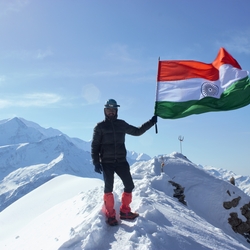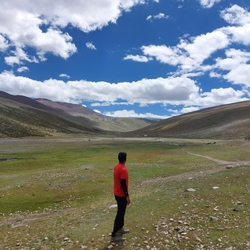Headlamps are a crucial part of mountaineering gear, particularly at camps and on days which warrant an early start. Given that there is no other source of light during night time, headlamps are almost indispensable. Headlamps that are now available in the market are extremely light weight, offer a high range of beam distance, better battery life and also varied levels of brightness. With features varying from one model to another, it can be confusing to pick the headlamp that best suits your needs.
This article delves into the significance of headlamps and explains each of its different features in order to help you understand and choose one which meets your requirements.
Significance of Headlamps
Mountaineering expeditions inevitably take you to places with no artificial source of light. There could be days when you reach the campsite after sunset or start your day before sunrise. Headlamps then become essential to not only light up the path but to also pitch your tents for the night. They also have the following advantages which makes them handy:
Allows you to use your hands freely: Headlamps, as their name implies, fit over your head and do not require you to use your hands to hold up light as you would need to with regular flashlights. This allows you to perform tasks in the dark without the hassle of having to hold a lamp in one hand. In the event that you are climbing up or down in the dark, the headlamp allows you to use your hands for balance and for holding on to the ropes or other climbing equipment while also shining light on the path ahead. Mountaineering helmets also have little hooks to tuck in the straps of the headlamp to hold it in place so that there is no loss of light from weaning it under your hemet and the headlamp can be operated easily, if you need to shift between its various settings, while you have your helmet on.
No risk of dropping: Given that the headlamp is fitted over your head with the webbing or straps that come with it, there is no risk of dropping it while performing tasks or during a climb/descent in the dark.
No risk of tiring out your arms: Holding a flashlight in a certain direction for a long time takes a toll on your arm. Setting up tents and cooking food during the expedition takes time and it is extremely uncomfortable to hold a flashlight for the entire duration. Headlamps make this easier and eliminate the need to use (and tire out) your arms.

Factors Affecting your Choice of Headlamp and their Usage
Beam Type: Headlamps come with three different types of beam; Flood, Spot and Adjustable beam. Headlamps with flood beams are useful for reading, repair work and general camping tasks. They do not light up long distances ahead of you. Spot beams are a better choice for navigating a trail in the dark - they allow long-distance viewing. Adjustable beams are the most versatile out of all and allow you to change the beam depending on your requirement.
Lumens: This quantifies the light emitted by the headlamp at source. These typically range between <100, 100-200 and 250-500. Although brighter, headlamps that emit higher lumens consume energy a lot faster.
Beam Distance: While lumens quantify brightness of the headlamp at source, beam distance quantifies the distance which can be illuminated by the headlamp.
Battery Life: This gives you an idea as to how long your headlamp will run before dimming out from the time it is fully charged. Earlier headlamp manufacturers used the point where the headlamp could no longer emit usable light as the standard. However, the new standard measures battery life based on 10% of the lamp’s original brightness, i.e. a 350 lumen headlamp will specify that it will run out after 2 hours even though it can provide diminished illumination for another 38 hours.
Weight: Most headlamps are lightweight without any substantial variations in size. However, high-powered headlamps that are used in long mountaineering expeditions are bulkier with high quality straps/webbing and external battery packs.
Brightness Levels: A low level of brightness is typically used to perform most camp chores and also navigate an easy trail at night. Headlamps also come with the mid and high option to increase the brightness based on need. There is a strobe or flash option which acts as an emergency blinker when needed. Some headlamps also allow you to set the pace of strobe light. An extra feature called the ‘zoom mode’ can be found on a few models which allows you to project intense beam for a few seconds. This drains a lot of energy and is not advisable to use unless absolutely necessary.
While these are the primary factors that will affect your choice of a headlamp, there are also additional features that headlamps offer such as red light mode and water resistance that you can consider depending on your requirements. Be sure to go through the specs of the headlamp thoroughly before buying one for yourself so that it serves your purpose as you need it to.
We hope this quick guide on the significance and specs of a headlamp helps you in picking the best one for yourself. Should you have further doubts or queries you want to resolve before purchasing one, our team is always available to help you out!






